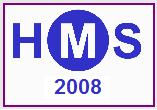|
Call For Papers
Automation Effects and Advanced Container Handling Technologies at Seaport Container Terminals
Track at the International Workshop on Harbour, Maritime & Multimodal Logistics Modelling and Simulation(HMS 2008)
Track Chairs: Stefan Voss (a), Jürgen W. Böse (b) Affiliation: (a) University of Hamburg (Germany), (b) HPC Hamburg Port Consulting GmbH (Germany)
Contacts: (a) stefan.voss@uni-hamburg.de, (b) j.boese@hpc-hamburg.de
Track Description Seaport Container Terminals (SCT) operate as central nodes in worldwide hub-and-spoke networks and link ocean-going container vessels with in-bound and out-bound hinterland container transportation using road, rail, or inland waterways. Over the last five decades, the international container flows have gained in importance with considerable operations challenges for terminals. The handling volume of SCT reached new records, frequently with double-digit annual growth rates. Stimulated by throughput demands and a stronger competition between terminals located in the same region or serving a similar hinterland noteworthy logistics and economic requirements arise for most of these facilities, in particular relating to their container handling capacity as well as to “acceptable” terminal operations cost. In this Track we investigate automation effects and related scalability issues at SCTs. Special attention is paid towards advanced container handling technologies and related planning issues.
Operations capacity and cost represent key indicators for competitiveness of SCT and are influenced by a multitude of factors. Basically, one may distinguish between internal and external influencing factors. The former are changeable by terminal operators and mainly comprise the management of available handling equipment and labor. The latter or their characteristics respectively “are given” and can be influenced on-site only to a certain degree. Typical examples for external factors are the local application conditions (like the level of energy and labor cost), specific attributes of used equipment (e.g., stacking height or manning requirements) as well as the size of container terminals. In general, external factors fix the basic level of economic and capacitive efficiency of terminals in a long-term view assuming common characteristics for internal factors (i.e. standard concepts and rules for organization). Internal factors (being adaptable by parties involved in logistics processes) determine the optimization potentials and enable their exploitation by effective use of terminal resources at short notice.
Regarding the track topic as well as existing influences on competitiveness of SCT, all contributions are welcome that deal with technical and/or organizational innovations leading to beneficial effects on terminal operations, e.g., like changes in handling equipment (long-term view) or use of algorithms for decision support (short-term view).
Key Dates Submissions of Extended Abstracts (extension) May 5, 2008 Notification of acceptance: May 20, 2008 Early Registration: June 10, 2008 Final Camera-Ready Submission (extension) June 24, 2008
Authors' Guidelines (further information author’s instruction section) FIRST SUBMISSION Extended abstracts (minimum 2 pages), full draft papers or other proposals should be submitted for the review process through the submission section by May 5, 2008. The extended abstract or the full draft paper must contain title, authors, affiliations, addresses, main body and references. Each extended abstract or full draft paper will be reviewed by at least two members of the International Program Committee taking into consideration scientific quality, originality and relevance. Only original papers, written in English will be accepted. The extended abstract or the full draft paper should be prepared by following the final paper formatting. However any type of paper formatting can be accepted for the first submission.
NOTIFICATION OF ACCEPTANCE Notification of acceptance will be sent by May 20, 2008.
CAMERA READY PAPER SUBMISSION The International Program Committee will accept two types of camera ready papers: extended paper (10 pages, 2 columns); regular paper (6 pages, 2 columns) both for regular and special sessions. The camera ready paper must adhere to the conference template. The .dot file contains the complete instructions for preparing a camera ready copy for the Proceedings. The final version of the paper must be a PDF file. Your camera ready paper (extended paper or regular paper) in PDF format must be submitted by using the submission section before the 24th of June 2008 The page limit for manuscripts is ten (10) pages (included in the author registration fee). Additional pages will require an additional fee. If your work must be cleared or approved before publication by your institution, company, or governmental agency, please be sure that process will be completed by the due date above or we will not be able to include it in the CD Conference Proceedings.
|
|
HMS, 2008 |
The International Workshop onHarbor, Maritime & Multimodal Logistics Modelling and Simulation September 17-19, 2008 Campora San Giovanni, Amantea (CS), Italy |


|
For further information please contact Stefan Voss, Jürgen W. Böse |







